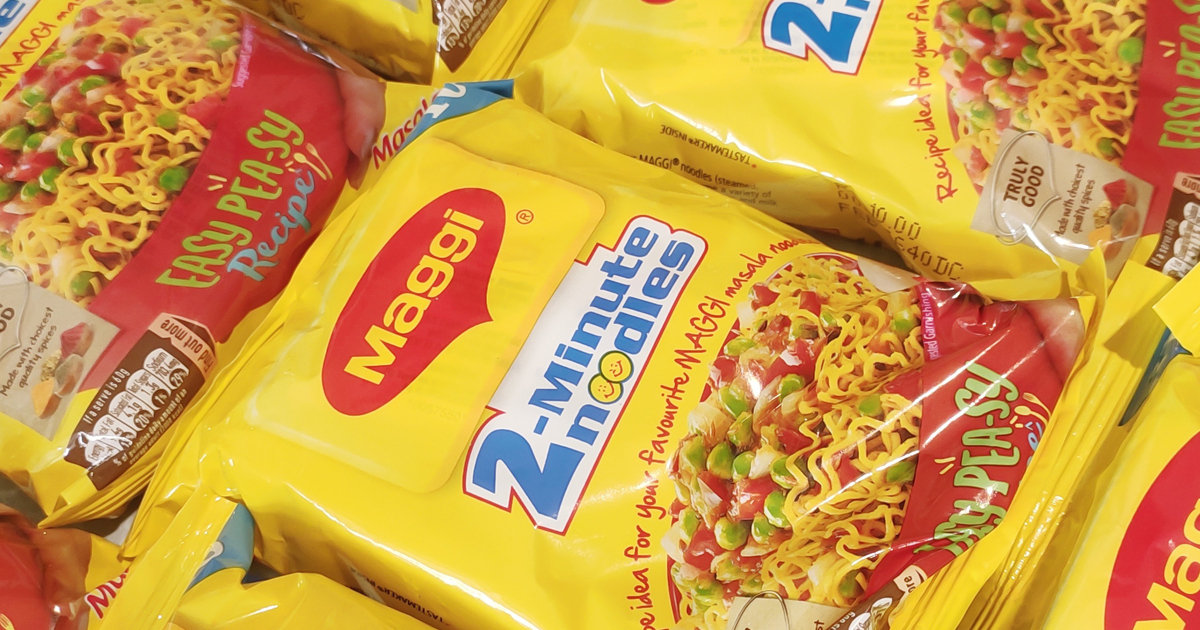Stories
Maggi: The Story Of The Simple Noodles Which Became An Iconic Indian Snack

If you are an Indian there is no chance that you would have missed seeing the simple Maggi masala noodles on Indian streets. The bright yellow packaging is hard to miss when visiting any grocery store or supermarket. Maggi is undoubtedly the king of Indian snacks and wildly popular with youngsters across the country for its quick cook time and ease of preparation. Many a student or bachelor must have definitely whipped themselves up a quick bowl of warm Maggi noodles because they were feeling lazy or just simply craving for a bowl of goodness. However, this iconic brand has a long history starting with its introduction to Indian markets to the current day where it is available almost everywhere.
Beginnings:
The Maggi brand was originally born in Switzerland in 1886 by Julius Maggi when the government tasked him with making a food product that is not just fast to cook but also delicious to taste. After a few experiments, Julius came up with a pea and bean soup which was simple and quick to cook. After further experimentation Julius figured out that a cheap but delicious food product would be helpful for industry workers and that was when he came up with the idea of soups, sauces and flours prepared from pulses. In the year 1897 Maggi GmBH was founded in Singen, Germany. Nestle group later acquired Maggi in 1947. Maggi products are extremely popular in India, Bangladesh, Malaysia, Pakistan and many other countries in the Middle East.
ALSO READ: How These Indian Startups Are Adopting Hydroponics To Harvest Fresh Produce
Brand Spread in India
The introduction of the humble Maggi noodles dates back a few decades to the early 1980s when the Indian Cricket team won its first World Cup in 1983. Maggi was introduced as a brand and it was marketed as a food that could be cooked in two minutes. The ‘2 minute noodles’ became a catchphrase that is synonymous with Maggi noodles in India. Nestle’s relationship with India goes back to 1912 when it launched in the country as The Nestle Anglo-Swiss Condensed Milk Company while India was still under colonial rule.
Nestle used to originally manufacture Milkmaid, a sweetened and condensed milk. After the Indian independence in 1947, Nestle realised that they were sitting on a potential gold mine and formed its Indian subsidiary in 1961 and opened its first factory in Moga, Punjab when it recognised the newly formed Indian government’s emphasis on local production. The choice of the location was also government-dictated and steered by the socialist idealism of India’s first Prime Minister Jawaharlal Nehru, who wanted Nestle to develop the milk economy of Punjab.
The two minute noodles advertising campaign became a hit with mothers and children as the ads focused on the motherly love to cook up delicious food for their children. The message was one of liberation for women as the noodles were very easy to cook and tasty to eat which meant a very little effort on the part of the mothers. This made Maggi very attractive among the women in India.
Maggi quickly spread like wildfire and was able to command 90% of the quick noodles market it had created within its first 25 years of launch. When the brand launched the Me and Meri Maggi campaign (Me and My Maggi,) in its silver jubilee year in 2008, inviting people to send in their personal Maggi stories, its advertising agency Publicis Capital was deluged with more than 30,000 entries. Even today people can hum the Maggi Maggi song which comes in the television advertisements. India today is the biggest market for Maggi noodles in the world, despite the serious challenge mounted on the brand by rival Top Ramen.
ALSO READ: How One Indian Startup Is Tackling The Problem Of Floral Waste
Maggi, along with the buffet of complementary products – soup mixes, sauces and cup noodles – contributes more than 20% of Nestle India’s revenue, clocked around 15 billion rupees in annual sales in 2015.
Ecosystem
Today Maggi has spawned a slew of entrepreneurs who have set up their own businesses to sell the noodles in various kinds and forms like the soupy noodles, schezwan noodles, cheesy noodles, fried noodles and a long list of other delicacies. It is easy to find a store selling hot cooked Maggi in any corner of India be it the Himalayan ranges, the Indian Ghats, the Indian shores and any remote location. Maggi has managed to transcend economic divide as it is enjoyed by people from all classes.
Maggi has managed to dig its roots deep in the Indian culture and is an integral part of the Indian gastronomy scene. Maggi managed to become an Indian ‘staple food’ after wheat and rice. There is no doubt that the popularity of Maggi will only continue to grow in the future. Let us know when you had your favourite bowl of Maggi noodles!
Entrepreneur Stories
Indian Man Quits JPMorgan, Takes 70% Pay Cut to Launch $6 Million Startup

Leaving behind a high-paying job at JPMorgan, an Indian entrepreneur embraced a 70% salary cut to pursue true purpose and passion in the startup world. Disenchanted with what he described as a “robotic” corporate routine, he sought meaningful work that made a real impact. This pivotal decision marked the beginning of his new journey, one focused on value creation rather than titles and corporate perks.
Powered by resilience and fresh perspective, the entrepreneur launched his own startup, prioritizing innovation and hands-on solutions. The road was challenging, but his vision resonated with the market: the startup quickly gained traction and raised $6 million—an impressive acknowledgement of its potential in a competitive landscape. Every hard lesson from early setbacks and bootstrapping paid off in real customer growth and investor confidence.
Today, his journey stands as an inspiring example for professionals seeking authentic success outside the corporate grind. By trading comfort for creative freedom, he grew a venture that solves important problems, generates jobs, and builds wealth beyond just salary. For ambitious founders, his story highlights the power of risk-taking, adaptability, and relentless focus on impact in India’s thriving startup ecosystem.
Videos
Larry Page: The Visionary Co-Founder Behind Google’s Global Success

Larry Page is a visionary technology entrepreneur and co-founder of Google, one of the world’s most influential companies. Born in 1973 in Michigan, Page grew up surrounded by computer technology, which inspired his passion for innovation from an early age. He studied computer engineering at the University of Michigan and later pursued his PhD at Stanford University, where he developed the revolutionary PageRank algorithm with Sergey Brin. This technology fundamentally changed the way search engines rank websites, making Google the most accurate and popular search engine globally.
The journey of Larry Page and Google began in 1998 when they officially launched the search engine from a small garage. Leveraging their unique algorithm, Google quickly surpassed competitors due to its ability to deliver highly relevant search results, transforming internet search forever. Under Larry Page’s leadership as CEO, Google expanded beyond search to launch groundbreaking products including YouTube, Gmail, and Google Maps, turning it into a global tech powerhouse that shapes how we access and interact with information online.
Larry Page later became the CEO of Google’s parent company, Alphabet Inc., driving innovation and investment in next-generation technologies such as artificial intelligence, autonomous vehicles, and healthcare solutions. His visionary leadership and commitment to technological advancement have cemented his legacy as one of the most influential figures in the tech industry. Today, Larry Page remains a key influencer in shaping the future of technology and digital innovation worldwide.
Entrepreneur Stories
India’s Tech Story: Airtel Spreads AI Access, Ohm Mobility Lessons

Bharti Airtel has launched the innovative “Airtel-Perplexity Blueprint,” partnering with Perplexity to provide over 360 million customers free access to Perplexity Pro for a year—a benefit valued at ₹17,000 ($200). This collaboration enables Airtel users across mobile, broadband, and digital TV to harness advanced capabilities in generative AI, including leading AI models like GPT 4.1, Claude, and Gemini, along with up to 300 Pro searches daily, image generation, document analysis, and personalized planning services. The move is seen as a milestone for telecom innovation and the democratization of AI in India, making powerful research and productivity tools accessible to a massive user base.
This strategic partnership positions Airtel as an “AI-first” telecom provider, allowing it to gain key insights into user interactions with artificial intelligence and adapt its networks for growing digital demands. For Perplexity, the tie-up grants exclusive access to India’s vast telecom audience, rapidly propelling the app to the No. 1 spot on the Indian App Store, surpassing global competitors like ChatGPT and Google Gemini. Airtel customers can activate their complimentary subscription seamlessly through the Airtel Thanks App, under the Rewards and OTTs section, reinforcing Airtel’s commitment to digital customer empowerment.
The broader Indian startup ecosystem reflects both breakthrough innovation and hard-earned lessons, illustrated by the recent shutdown of Ohm Mobility, an EV financing startup. Despite multiple pivots and industry-leading investors, Ohm Mobility struggled to achieve a sustainable business model—a reminder of the challenges in market fit and adaptability. As AI adoption accelerates and startup realities evolve, industry leaders like Airtel and Perplexity are setting new standards, while others, like Ohm Mobility, offer valuable insights on resilience and the importance of business model flexibility in India’s dynamic tech landscape.














priligy drug company
May 29, 2025 at 2:18 pm
priligy sg Ruth Kava finds the core of the article to be very confusing
J88
November 6, 2025 at 5:01 am
Đến với J88, bạn sẽ được trải nghiệm dịch vụ cá cược chuyên nghiệp cùng hàng ngàn sự kiện khuyến mãi độc quyền.
谷歌站群
November 7, 2025 at 10:05 am
专业构建与管理谷歌站群网络,助力品牌实现全域流量的强势增长。谷歌站群
站群程序
November 9, 2025 at 3:15 am
搭载智能站群程序,自动化搭建与管理,为SEO项目提供核心驱动力。站群程序
MM88
November 10, 2025 at 2:07 am
Với giao diện mượt mà và ưu đãi hấp dẫn, MM88 là lựa chọn lý tưởng cho các tín đồ giải trí trực tuyến.
Kuwin
November 12, 2025 at 7:32 am
kuwin sở hữu kho game đa dạng từ slot đến trò chơi bài đổi thưởng, mang đến cho bạn những giây phút giải trí tuyệt vời.
ios超级签
November 14, 2025 at 1:10 am
苹果签名,苹果超级签平台,ios超级签平台ios超级签苹果企业签,苹果超级签,稳定超级签名
GO88
November 26, 2025 at 3:06 am
Tham gia cộng đồng game thủ tại Go88 để trải nghiệm các trò chơi bài, poker phổ biến nhất hiện nay.